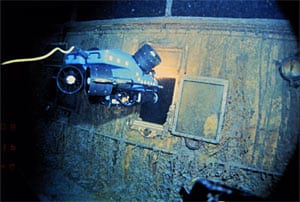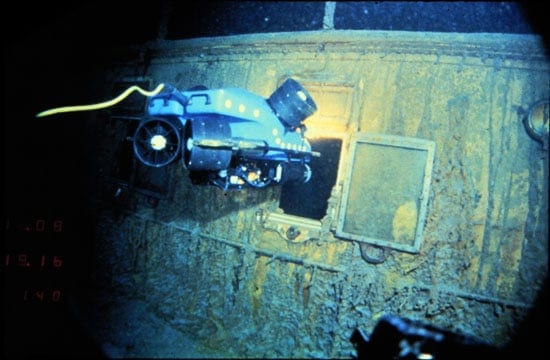Woods Hole Engineering Team from Titanic Discovery to be Honored
 In 1986, WHOI researchers explored the hull of the Titanic with the remotely operated vehicle (ROV) Jason Jr. (above), which was designed and built in six months for the expedition. (Copyright © Woods Hole Oceanographic Institution )
In 1986, WHOI researchers explored the hull of the Titanic with the remotely operated vehicle (ROV) Jason Jr. (above), which was designed and built in six months for the expedition. (Copyright © Woods Hole Oceanographic Institution ) July 11, 2006
The underwater research vehicle Jason Jr., which gained international attention for its exploration inside the wreck of the R.M.S. Titanic in July 1986, and its engineering team from Woods Hole Oceanographic Institution (WHOI) will be honored July 14 with the 2006 GlobalSpec Great Moments in Engineering award.
The honor comes on the 20th anniversary of the Institution’s second expedition to the wreck of Titanic, nine months after the initial discovery by an unmanned towed camera system named Argo. At the time the Deep Submergence Laboratory (DSL) at WHOI, part of the Applied Ocean Physics and Engineering Department, was developing the dual vehicle Argo/Jason system for deep ocean exploration. Jason Jr. was a prototype meant to test design concepts for the planned and much larger remotely operated vehicle (ROV) Jason, which is controlled from the surface via a fiber-optic cable miles long.
“The DSL engineers have made significant advances in the development of ROVs for ocean research, in the use of fiber optics and in underwater imaging,” Acting WHOI President and Director James Luyten said. “They proved in 1986 that small unmanned vehicles could be used in very deep water, in tight spaces and amid wreckage too dangerous for humans to explore in larger submersibles like Alvin. They helped pave the way for the routine use of remotely operated vehicles, and now autonomous underwater vehicles, for scientific, military, and commercial needs.”
In 1983, the U.S. Navy’s Office of Naval Research (ONR), and later the Office of Naval Technology (ONT), awarded DSL $2.8 million to build a revolutionary exploration vehicle system called Argo/Jason. The first phase of that development effort was the building of the Argo search system, a towed vehicle equipped with low-light level television cameras and capable of working to depths of 20,000 feet. Argo was successfully tested in the summer of 1985 at the Titanic site, resulting in the luxury liner’s discovery.
Testing of the prototype Jason vehicle, a much smaller remotely operated or tethered vehicle named Jason Jr., and development of a fiber optic handling system for use in the deep sea was a major challenge in 1986. Fiber optic cables, although common today, were not in use in the deep sea and required significant engineering advances. Unlike traditional coaxial cables with limited bandwidth, fiber optic cables permit transmission of vast amounts of color imagery, other data and power. No one had successfully operated an ROV in very deep water, nor used a fiber optic cable system like this in the deep sea.
The original Jason was retired after ten years of successful operation and replaced in 2002 with the current Jason, capable of reaching depths to 6,500 meters (21,320 feet). That vehicle, currently at sea in the western Pacific, is part of the U.S. National Deep Submergence Facility operated by WHOI for the American ocean research community.
The award, a trophy, will be presented to Christopher von Alt, Jason Jr. principal engineer, and other members of the 1985-1986 Jason Jr. engineering team at a breakfast ceremony at the New England Aquarium in Boston.
# #
About the Award The GlobalSpec Great Moments in Engineering award is presented annually to a person or group whose singular moment of engineering ingenuity produced a significant turning point for the application of technology and resulting benefits to people, science and industry. The 2005 award was presented to NASA engineers from April 1970 responsible for saving lives of crew members during the harrowing flight of Apollo 13.
GlobalSpec, Inc. is the leading specialized vertical search, information services and e-publishing company serving the engineering, technical and industrial communities, providing access to comprehensive technical content on standards, patents, materials properties, specifications, designs, application notes and more. Visit GlobalSpec at www.globalspec.com.

